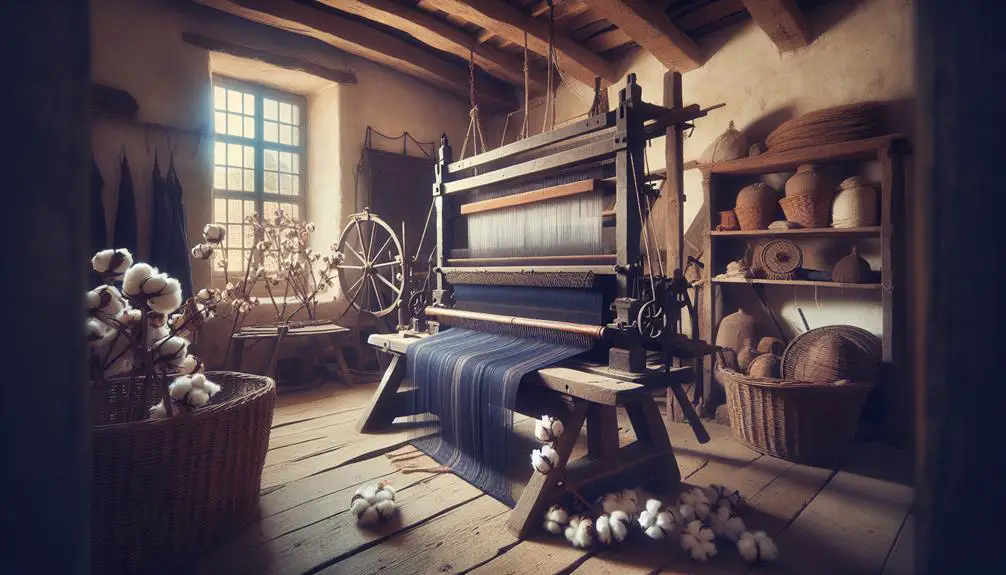I've always found it fascinating how some pieces of clothing have such rich histories, and denim's no exception. Did you know it traces back to Nîmes, France? That's right, the very fabric we now associate with cowboys and casual Fridays started its journey in a French city, known for its textile mastery. It's intriguing to think about how 'serge de Nîmes' evolved into the denim we know today. But there's a lot more to this story, especially how it went from French fabric to global fashion staple. Stick around, and I'll share some insights that might just surprise you.
Table of Contents
Key Takeaways
- Denim originated from Nîmes, France, known for creating the "serge de Nîmes" fabric.
- The fabric's name, "serge de Nîmes," highlights its French origins and connection to Nîmes.
- Italian influence is noted in the development and refinement of the denim fabric.
- The decline of Nimes' textile industry impacted the traditional production of denim.
- French roots add sophistication and historical significance to the evolution of denim.
Denim's French Roots
Did you know that denim's journey began in Nimes, France, where they crafted the iconic 'serge de Nimes' fabric? This piece of textile history has always fascinated me, especially considering its transformation into the denim we know today. The key to its unique look? The twill weave and indigo dye that became denim's signature. Honestly, it's like a piece of France wrapped around you, showcasing the country's deep connection to the fashion and textile industry.
The French roots of denim don't just add a touch of elegance; they're a testament to the skill and craftsmanship that went into creating this durable material. Back in the 17th century, Nimes was buzzing with textile production. It's mind-blowing to think about how these early fabric makers laid the groundwork for what would become a global fashion staple. But as Nimes' textile industry began to decline, so did the production of the original denim fabric. It's a bit sad, really, to see such an important piece of textile history fade away in its birthplace.
Yet, this story isn't just about a fabric; it's a reminder of the importance of preserving and valuing our cultural heritage in the fashion industry.
The Etymology of Denim
Delving into the term 'denim,' it's fascinating to see how it traces back to the French city of Nimes, highlighting a rich history woven from the 'serge de Nimes' fabric. This connection not only points to its geographical origins but also sheds light on the cultural interplay between French and Italian textile traditions that shaped the denim we know today.
Here's why this etymology is a game-changer:
- Serge de Nimes: Understanding this term is essential for appreciating denim's evolution from workwear to a global fashion staple.
- Italian Influence: The parallel development of 'blue jeans' in Genoa underscores the blend of French fabric technology with Italian craftsmanship.
- Indigo Dye: The iconic blue color that defines jeans owes its existence to the indigo dyeing techniques that were perfected alongside denim's development.
- Fabric Technology: The twill weave that characterizes denim is a testament to the innovations in fabric technology that have allowed it to endure and adapt over centuries.
Grasping these elements gives us a deeper appreciation for denim's journey from the looms of Nimes and Genoa to becoming the quintessential fabric of fashion and utility.
Serge De Nîmes Evolution
So, we've seen how 'denim' got its name from the French city of Nîmes, right?
Now, let's look at how this tough fabric made the leap from workwear to global fashion staple.
It's a journey that took denim from its origins in France, through its transformation into a fashion icon, to its expansion across the globe.
Origin in France
France's role in the birth of denim, through the creation of 'serge de Nîmes' in the late 17th century, can't be overstated. Let's dive into why this fabric's French origins are so crucial:
- Serge de Nîmes: This is where our beloved denim fabric originally comes from. It's not just fashion; it's history woven into threads.
- French origins: Knowing denim started in France adds a layer of sophistication and depth to our everyday wear.
- Indigo dye: The vibrant blue that defines denim? That's thanks to the indigo dye techniques perfected in Nîmes.
- Weaving techniques: These weren't just any old methods. The unique weaving techniques developed in Nîmes set the groundwork for what denim would become.
It's fascinating to see how deep denim's roots go into French soil, isn't it?
Fabric to Fashion Transition
The journey of denim from tough workwear to global fashion icon really shows how a fabric can weave its way into the fabric of our lives.
Originating as 'serge de Nîmes', this durable fabric, known for its distinctive blue color, wasn't always the fashion statement it's today. Initially, it was all about durability, spun from white and indigo yarn to withstand the rigors of hard labor.
But let's not kid ourselves; the transition of denim into fashion wasn't overnight. It's fascinating how this sturdy material evolved into a must-have in everyone's wardrobe. The fabric's strength, paired with its iconic blue color, made it a perfect canvas for fashion's ever-changing trends.
Denim's journey from function to fashion is a testament to its versatility and enduring appeal.
Global Denim Expansion
From its humble beginnings in Nîmes, denim's journey didn't stop at the French borders; it went on to conquer the world. As someone deeply fascinated by the denim industry, I've seen its global expansion first-hand. This fabric's evolution is nothing short of remarkable. Here's what caught my eye:
- Denim manufacturing spread from Italy to every corner of the globe, adapting to new technologies.
- The denim industry has become a titan, influencing fashion on a massive scale.
- Organic dye and recycled denim practices are reshaping the market, pushing sustainability forward.
- The quest for innovation has led to denim being more than just jeans; it's a statement.
Denim's journey from a small town in France to worldwide domination is a testament to its versatility and enduring appeal.
Indigo Dye Process
Diving into how denim gets its iconic color, it's all about the indigo dye process. Let me break it down for you. The magic behind that classic blue jean look comes from indigo dye. It's not just any dye; it's special because of how it impacts denim's appearance and those cool fading properties we all love.
Back in the day, natural indigo was the go-to. But here's the kicker: since 1878, synthetic indigo dye has taken the lead. Why? It's consistent, reliable, and let's face it, easier to produce on a massive scale. This synthetic champ gives denim its deep blue shades but also allows for those washed-down looks through processing.
Now, onto how they actually dye the denim. The rope dyeing technique is the gold standard for achieving those traditional blue denim colors. This method involves twisting yarns into a rope that's then dipped into the dye, ensuring that the core remains white. Over time, with wear and washing, this is what gives denim its unique fading characteristics.
Global Denim Production
Shifting gears, let's talk about how denim production became a global phenomenon.
We'll explore the historical cotton cultivation centers that laid the groundwork, highlight the leading denim manufacturers from around the world, and touch on the cool innovations in denim fabrication shaping today's trends.
It's fascinating to see how this fabric's journey has intertwined with technological advances and cultural shifts.
Historical Cotton Cultivation Centers
Exploring the global landscape, it's clear that cotton cultivation centers have significantly influenced denim's journey from local craftsmanship to worldwide staple. Let's dive into how this all ties back to a single place:
- Nimes, France: The birthplace of 'serge de Nimes,' the precursor to modern denim. This city's innovative weaving techniques set the stage.
- Twill Weave Creation: An accidental but revolutionary development in fabric making by Nimes' weavers.
- Textile Center: Nimes wasn't just a city; it was a hub for textile innovation in the 18th and 19th centuries.
- Global Shift: The decline in Nimes' textile dominance paved the way for denim's global journey, emphasizing the importance of these historical cotton cultivation centers.
Leading Denim Manufacturers Worldwide
Asia leads the pack in denim production, accounting for more than half of the global output. It's fascinating to see how countries like China, India, Turkey, Pakistan, and Bangladesh have become powerhouses in the denim world. This dominance is a huge shift from the early days when Levi Strauss and Jacob Davis kicked off the denim craze in the United States.
Today, the global denim market is a whopping $57.3 billion industry, and it's growing steadily. Key players in Asia aren't just contributing; they're shaping the future of denim with innovative and sustainable practices. It's a competitive field, sure, but it's also ripe with opportunity for growth. This dynamism is what keeps the global denim market so vibrant and exciting.
Innovations in Denim Fabrication
In the world of denim production, innovation isn't just a buzzword; it's the key to staying ahead in this ever-evolving market. The traditional process of turning cotton fiber into the denim we love involves a few critical steps that have seen some pretty cool advancements:
- Indigo Dye Techniques: New methods ensure richer colors with less environmental impact.
- Weaving: Shuttle looms are giving way to modern machinery that speeds up production without sacrificing quality.
- Sanforizing: This crucial process, which prevents shrinking, has become more efficient, ensuring that your jeans keep their fit after washing.
- Sustainable Cotton Fiber: Innovations in cotton cultivation aim to reduce water and chemical use, making denim production kinder to our planet.
Mastering these innovations is what keeps global denim production dynamic and exciting.
Levi Strauss & Co. History
I've gotta say, Levi Strauss & Co.'s journey, starting back in 1853 in San Francisco, is a real game-changer for the denim world. This company didn't just sell fabric; they revolutionized how we see and wear denim. Imagine, back in the day, Levi Strauss, an immigrant from Germany, kicks off this iconic brand, diving into the booming trade and outfitting folks with top-notch dry goods.
Fast forward to 1873, and this is where things get spicy. Levi Strauss & Co., alongside Jacob Davis, a tailor with a genius idea, patented the first riveted denim work pants. This wasn't just another piece of clothing; it was the birth of what we now know as blue jeans. The introduction of riveted denim was a game-changer, making these pants a must-have for hardworking people needing durable wear.
The leap from utilitarian workwear to an everyday staple wasn't overnight, but Levi Strauss & Co. laid the foundation. Their partnership with Jacob Davis didn't just revolutionize the denim industry; it stamped their name in history as the pioneers of blue jeans. Seeing how they turned a basic need for durable work pants into an iconic fashion statement is nothing short of remarkable.
Denim as Fashion Statement
Denim's leap from practical workwear to a bold fashion statement really took off in the 1950s, thanks to cultural icons like Elvis Presley and James Dean. Their embrace of denim jeans not only amplified its popularity but cemented its place in American culture as a symbol of youth and rebellion. Suddenly, what was once seen as mere denim workwear transformed into a must-have fashion staple, showcasing its unique fashion appeal.
Here's why denim's transition was a game-changer:
- Cultural Endorsement: Icons made denim cool, influencing millions to adopt the style.
- Appeal Beyond Utility: The fashion appeal of denim went beyond its durability, becoming a canvas for personal expression.
- Innovation by Brands: Companies like Levi Strauss started catering to this new demand, blending tradition with trends.
- Durability Meets Style: The unique characteristics of denim—its yarn, dye, and finishes—offered both resilience and a distinct look that appealed to the masses.
This evolution reflects denim's incredible journey from humble beginnings to becoming an irreplaceable part of fashion history. It's not just fabric; it's a statement, a piece of cultural heritage that continues to evolve and inspire.
The Rise of Designer Jeans
The 1980s saw the birth of designer jeans, a trend that revolutionized how we view denim. Before this, jeans were just sturdy, everyday wear, not something you'd flaunt for their brand or design. But then, brands like Calvin Klein and Guess stormed onto the scene, turning denim into a canvas for fashion expression. They weren't just selling jeans; they were selling a lifestyle, a piece of luxury.
Designer jeans were all about premium quality. The denim was softer, the cuts were more flattering, and the details—oh, the details! Think intricate stitching and logos that screamed exclusivity. This wasn't just clothing; it was art. And with art comes a hefty price tag. Suddenly, owning a pair of designer jeans became a status symbol. It said, 'I understand fashion. I can afford this.'
This shift wasn't just about looking good. It was a fashion trend that signaled a new era in how we express identity through what we wear. Designer jeans weren't just pants; they were a statement. And I was all in for it, embracing this trend that blurred the lines between everyday wear and high fashion.
Denim in Popular Culture
Surging into the limelight, denim became a cultural icon in the 1950s, thanks to American pop culture and Hollywood legends like Elvis Presley and James Dean. Initially, this sturdy cotton fabric, dyed with indigo, was the go-to workwear for blue-collar workers. But then, something fascinating happened. It transformed from purely functional attire into a fashion statement. Let me break down how denim took over the world:
- Hollywood Influence: Icons like Presley and Dean made denim synonymous with cool, rebelling against the norms and setting the stage for denim's fashion takeover.
- From Workwear to Everywhere: Once seen as suitable only for hard labor, denim became a staple in everyone's wardrobe, thanks to its durability and comfort.
- Fashion Evolution: Companies like Levi Strauss and H.D. Lee seized the moment, innovating and catering to new fashion trends, pushing denim beyond its humble beginnings.
- Cultural Shift: Denim's adoption by various subcultures over the decades cemented its place in fashion history, making it a timeless piece that's always in vogue.
The Future of Denim Industry
Looking ahead, the denim industry's future seems to be all about going green and high-tech.
I've noticed more brands are adopting sustainable practices and using new tech to lessen their environmental footprint.
Plus, keeping an eye on global market trends shows that consumers are really pushing for this shift.
Sustainable Practices Adoption
As denim brands increasingly go green, they're meeting a growing consumer demand for eco-friendly jeans. It's clear that both premium and fast-fashion sectors are stepping up, weaving sustainability into the very fabric of their production lines. Here's what's making the cut in the shift towards more sustainable denim:
- Eco-Friendly Manufacturing Processes: Reducing water usage and minimizing chemical waste.
- Use of Environmentally Friendly Technologies: Innovations aimed at lowering carbon footprints.
- Integration of Sustainable Materials: Incorporating organic cotton and recycled fabrics.
- Adoption of Natural Indigo Dyes: Moving away from synthetic dyes to reduce pollution.
The denim industry's pivot towards these practices isn't just a trend; it's a testament to a growing commitment to planet-friendly fashion.
Technological Innovations Impact
The denim industry's game is changing thanks to tech innovations like laser etching and ozone finishing. We're talking major leaps in how our favorite indigo-dyed threads are made, with a nod to the past when German chemist Adolf von Baeyer first synthesized indigo dye. Now, we're slashing water use and making the whole process cleaner and more efficient.
With the advent of RFID technology, the denim market's getting smart about tracking products, cutting down on waste like never before. Plus, automated cutters and digital looms? They're pushing precision and speed to new heights. And let's not forget stretch denim; it's getting a high-tech boost from 3D design software, making customization and prototyping a breeze. We're weaving tech into every thread, and it's downright exciting.
Global Market Trends
After exploring the tech innovations reshaping denim production, let's focus on how the global market is gearing up for a future where growth and sustainability go hand in hand. Here's what you need to know:
- Massive Growth: The market's set to hit $76.1 billion by 2026, thanks to key players like China and India.
- Sustainability Is Key: Brands are weaving sustainable practices into every seam, aiming to reduce their environmental footprint.
- Back to Roots: The focus on quality denim, with nods to its origins from the fabric called Serge and dyes from Indigofera tinctoria, highlights a blend of tradition and innovation.
- Tech Meets Tradition: Innovations aren't just about style but integrating eco-friendly tech, a nod to the work of pioneers like German chemist Adolf von Baeyer.
This blend of growth, sustainability, and respect for tradition is shaping a resilient future for denim.
Frequently Asked Questions
Where Did Denim Originally Come From?
I've always been curious about denim's roots. Turns out, it's from Nimes, France. They crafted "serge de Nimes" back in the 17th century. So, denim's not just fashion; it's a piece of history.
What Country Is Known for Denim?
I've learned that while Italy is known for its denim production today, denim's roots trace back to France. However, Asia now dominates the market, producing over half of the world's denim, shifting the traditional landscape.
Did Denim Originate in France?
Yes, I've learned that denim did indeed originate in France. It all started with the fabric 'serge de Nimes' in the 17th century, which eventually got shortened to 'denim.' It's fascinating how history shapes fashion!
Who Invented Jeans and Why?
I've learned Levi Strauss and Jacob Davis created jeans in 1873, aiming for durable workwear for miners. They added rivets to make them last longer, which turned jeans into a timeless fashion must-have.
- Choosing the Right Fabrics for Babies - July 20, 2024
- Impact of Fabrics on Skin Health - July 20, 2024
- Benefits of Antimicrobial Fabrics - July 20, 2024








